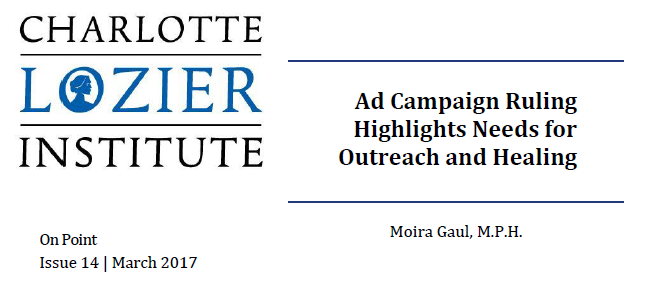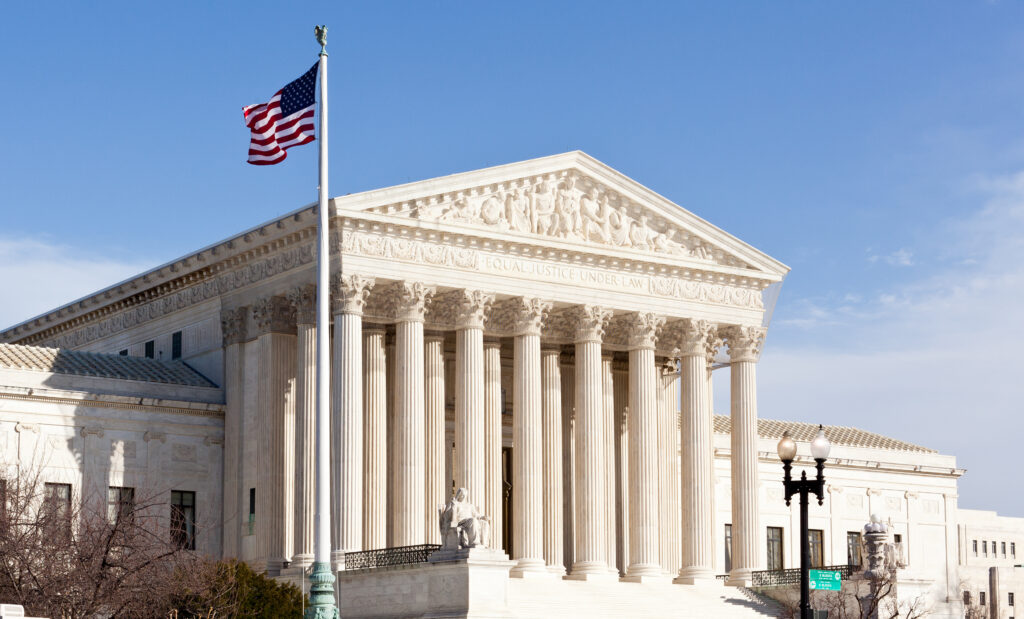Ad Campaign Ruling Highlights Needs for Outreach and Healing

This is Issue 14 of the On Point Series.
Last December a Canadian appeals judge ruled against the appearance of a provocative pro-life ad campaign on the exterior of municipal buses in Grand Prairie, Alberta.[1] Justice C. S. Anderson stated in her decision, “Expression of this kind may lead to emotional responses from the various people who make use of public transit and other uses of the road, creating a hostile and uncomfortable environment.”
The ad sponsored by the Canadian Center for Bio-Ethical Reform (CCBR) depicted three developing fetuses at seven and 16 weeks of gestation with the words under each “growing,” “growing” and under the last, obscured-in-red image, “gone.” The phrase “Abortion Kills Children” followed. Grand Prairie city officials disapproved the ads, leading to the CCBR’s filing suit on grounds of freedom of expression.
Justice Anderson also wrote that she had reviewed the CCBR purposes and goals in addition to taking into account potential effects on post-abortive women and any children who would see the ads. She noted that the CCBR website includes “strong statements that vilify women who have chosen, for their own reasons, to have an abortion; that are not merely informative and educational.” Anderson further wrote that the ad is “likely to cause psychological harm” to women who have had an abortion or those considering an abortion.
For its part, on its website, the CCBR (at the time of this writing) states, “But while the pro-life position certainly opposes—and condemns—the action of abortion, it seeks not to condemn the actors (women and men) who have made that decision.”[2]
Justice Anderson’s concern about the impact of the CCBR advertising on certain audiences is reasonable, whether or not her legal ruling is correct as a matter of Canadian law, much less as a matter of the human right to freedom of speech.[3] Leaving that matter aside for now, the issue of how society responds to the impact of abortion on individual women deserves much closer attention because abortion does not and never will have the status of a mere medical procedure neutrally chosen.
The emotional responses Justice Anderson referred to being prompted by the bus ad could be related to unresolved grief and/or trauma a woman may experience following an abortion. Similarly, a crying baby on the bus, an ad for abortion services, or images of a developing baby in utero with or without a message about abortion could evoke such responses. The need for after-abortion outreach is significant. With publicly voicing the fact that abortion ends a human life comes a social obligation to provide aid, be it a website, helpline, or other resource, where a woman who is hurting from her abortion experience (and potentially her partner and family members) can seek help.
Immediately or even decades afterwards, the mental health effects of abortion are very real. Current research suggests that a minimum of 10 to 30 percent of women may experience prolonged, adverse mental health responses after an abortion.[4] The research shows that women who have had an abortion are at higher risk for depression, anxiety disorders, sleep problems, substance abuse, suicide ideation and suicide.[5] Women who have had an abortion have been shown to be at higher risk for other mental health problems, including panic attacks, panic disorder, agoraphobia, post-traumatic stress disorder, and bipolar disorder.[6]
In addition, research findings reveal that abortion can destabilize relationships with adverse consequences. In particular, prior abortion was related to higher interpersonal aggression (verbal and physical) for both men and women.[7] A review of relevant, though limited, research studies and contextual theory application has demonstrated relationship problems significantly associated with abortion experience to include partner aggression/abuse, communication problems, sexual dysfunction and break-up of relationship (separation or divorce).[8]
The impact of the rising use of “medication” abortion on mental health is of increasing concern as well. According to the Guttmacher Institute, in 2001, medication abortion accounted for six percent of all non-hospital abortions and this share steadily increased to 31 percent of all non-hospital abortions in 2014. Further, medication or chemical abortion accounted for 45 percent of abortions before nine weeks of gestation in 2014. The two-drug protocol often involves a woman taking the second medication at home after being administered the first by a healthcare provider in an office or hospital. The aspect of the woman’s direct involvement in the abortion procedure with respect to effects on her mental health has yet to be fully evaluated.
In addition to fleshing out and addressing these questions, more efforts are needed to provide resources to the thousands of women and others involved in abortion who are seeking solace and support. One international outreach, Abortion Changes You, based in California, has been very influenced by the field of reproductive grief and loss. It acknowledges that there is a wide-range of emotions and reactions following abortion, and posits that the grief that women and men experience after an abortion can be similar to what is experienced after other types of reproductive loss (miscarriage, stillbirth, or infant death). All are pregnancy losses with the potential to precipitate reproductive grief.
Although each case is different, one mourning process which moves towards healing described in an Abortion Changes You resource, proceeds through four “tasks” over time: “accept the reality of loss”; “process the pain of grief”; “adjust to a world without the deceased”; and “find an enduring connection with the deceased in the midst of embarking on a new life.”[9] Grief becomes unresolved or complicated when one of the tasks or processes is impeded and cannot resolve. A person can feel “stuck” in grief. Complicated or disenfranchised grief can occur also when a person fails to grieve at all. While stillbirth, miscarriage, a newborn loss, loss via adoption and infertility are socially recognized losses, abortion, which may add the element of intention, represents a reproductive loss which may not be understood or even accepted as such. This social nonrecognition of loss can lead to disenfranchised and complicated grief.
Often because of delayed recognition, identification, acceptance, and progressive resolution women may experience disenfranchised or unresolved grief following an abortion, which may make it difficult to move beyond the abortion experience.
The mounting body of research concerning abortion and women’s health stands in stark contrast to a 2008 American Psychological Association (APA) report claiming that there is “no credible evidence that a single elective abortion of an unwanted pregnancy in and of itself causes mental health problems for adult women.” The APA’s Special Task Force on Mental Health and Abortion arrived at this finding amid criticism of shifting standards of research evaluation and bias in a seeming effort to produce a conclusion tailor-made for a legal abortion agenda. The finding echoed the APA’s position from two decades prior despite the newer scientific literature and other evidence to the contrary. The report’s risk factors for psychological harm following abortion – repeat abortion, coerced abortion, “wantedness” of the pregnancy, and even adolescent age – are reportedly not subject to regular and rigorous screening by abortion providers.
Indeed, there may well have been a political clarion call for such a finding from a national professional body given that just the year prior the U.S. Supreme Court had referenced post-abortion testimonies in the Gonzales v. Carhart majority ruling upholding the ban on the grisly partial-birth abortion procedure. The 180 testimonies detailing real-life experiences of how abortion had negatively affected each woman were included in a friend of the court brief. The Court noted in its ruling, “While we find no reliable data to measure the phenomenon, it seems unexceptionable to conclude some women come to regret their choice to abort the infant life they once created and sustained.” The Court added, “Severe depression and loss of esteem can follow.” The APA ignored the growing number of firsthand accounts from women themselves, as well as the science on abortion and mental health, and instead rubber-stamped a bogus finding, which is now being cited indiscriminately.
The repeated use of this APA finding, which is underscored when abortion providers do not refer women for appropriate mental health screening and care, morphs into the message that abortion doesn’t harm women’s health generally. In this type of environment, women can be deceived into believing that their feelings of grief and loss are invalid and misplaced, potentially leading to the disenfranchised and complicated grief mentioned previously. Such a state can greatly deter the affected woman from taking active steps to seek help.
Pro-life messaging as well as other related imagery and stimulus may induce a visceral response in someone who is post-abortive, particularly when cast against a culture where abortion is legal and permitted broadly and even praised as a leading facet of “reproductive healthcare.” Strong consensus exists and it is deeply embraced by mainstream pro-life groups that compassionate outreach to women hurting from their abortion experience is essential in communicating a pro-life message. This outreach, whether via website, helpline, other resource or just by statement, in itself could be classified as “informative and educational” and well within the demarcations set by Justice Anderson.
It should be noted that while photographs of aborted fetuses may provide a revealing glimpse of human lives lost to abortion, they do not belong in the public domain where children may be unknowingly exposed to the imagery and others are not able to decide in advance whether to view them.
With such a great need – it is estimated that between one in four and one in three women will have an abortion before the age of 45 in the U.S. – a number of abortion recovery organizations dedicated to reaching women with “hope and healing” have sprung up in North America.[10]
Life-affirming pregnancy help/resource centers, previously known as crisis pregnancy centers, provide after-abortion support as a core service to women in both the U.S. and Canada with at least 75 percent of centers of the 2,500 associated with the national networks offering this type of support in this country. Group leaders receive specialized training through national-network-approved resources and materials. Pregnancy center workers are sensitive to women’s needs. If a woman does not desire a faith-based approach, they may refer for professional counseling or provide her with a non-faith-based resource. These centers, which provide compassionate alternatives to abortion as well as a range of services to improve maternal and child health outcomes, are offering abortion recovery to men in growing numbers as well.
The Abortion Changes You outreach mentioned above takes a secular approach providing training and resources, and is “intended to be an invitation” to “begin the healing process.” The outreach includes an interactive website where men, women, family members and friends can anonymously share and explore a Healing Pathways model. The Healing Pathways model was developed in collaboration with Dr. Gary Strauss, a professor of psychology in the Rosemead School of Psychology at Biola University, who has incorporated a steps-toward-healing model. The outreach also includes trainings, a booklet to assist in reflection and journaling, a resource guide, as well as a “help locator” to assist individuals with finding bereavement support and professional care.
Numerous other after-abortion recovery organizations exist both nationally and internationally. Broad acceptance of the need for such care and recovery following abortion is another matter.
While it is unclear if the CCBR included a direct reference to after-abortion care on its municipal bus ads, it currently (as of this writing) devotes an entire page on its website to “After Abortion” with multiple abortion recovery resources listed. If this section was present when the Canadian judge reviewed the CCBR website, it would be difficult to understand how this information was not deemed “informative and educational,” to actually help women and individuals struggling following an abortion experience. Justice Anderson’s assertion that the CCBR “vilifies women” is unfortunately a common mantra among those who misunderstand and/or attack the pro-life position. Rather, in addition to being concerned about protecting unborn children’s lives, the overwhelming majority of pro-life advocates are concerned about protecting women’s health and wellbeing. The critical need for after-abortion support and care is not something society can close its eyes to.
For more information about the wealth of after-abortion resources available online please visit the following:
- American Association of Christian Counselors Find Help – aacc.net/resources/find-a-counselor/
- Abortion Changes You outreach – abortionchangesyou.com/
- Option Line to find phone support and to locate the life-affirming pregnancy help/resource center nearest to you. http://optionline.org/ 1-800-712-4357
- Pregnancy Decision Line to find phone support and to locate the life-affirming pregnancy help/resource center nearest to you. http://pregnancydecisionline.org/find-a-pregnancy-center 1-877-791-5475
- Rachel’s Vineyard http://www.rachelsvineyard.org/
- Silent No More http://www.silentnomoreawareness.org/
- Abortion Recovery International (ARIN) http://www.abortionrecoveryinternational.org/
Moira Gaul, M.P.H. is an Associate Scholar with the Charlotte Lozier Institute. She authored an Appendix, “For the Professional: A Public Health Perspective,” in the Abortion Changes You resource “Grief and Abortion: Creating a Safe Place to Heal” in which much of the research and information about unresolved and complicated grief mentioned in the article above is cited. http://creatingasafeplace.com/shop/grief-abortion-creating-a-safe-place-to-heal.
[1] Cleve R. Wootson, Jr., “Canadian judge bars anti-abortion bus ads – to prevent an uncomfortable environment,’” Tyler Morning Telegraph (January 11, 2017), http://www.tylerpaper.com/TP-News+World/268740/canadian-judge-bars-antiabortion-bus-ads-to-prevent-an-uncomfortable-environment.
[2] Canadian Centre for Bio-Ethical Reform, https://www.endthekilling.ca/.
[3] Universal Declaration of Human Rights, United Nations General Assembly Resolution 217 A (December 10, 1948), http://www.un.org/en/universal-declaration-human-rights/.
[4] Coleman, P.K. et al. “Intrapersonal processes and post-abortion relationship challenges: A review and consolidation of relevant literature.” Internet Journal of Mental Health 2007; 4(2). https://print.ispub.com/api/0/ispub-article/3804.
[5] Ferguson, D.M., et al. “Abortion in young women and subsequent mental health.” Journal of Child Psychology and Psychiatry 2006; 47(1):16-24; Pedersen, W. “Abortion and depression: A population-based longitudinal study of young women.” Scandinavian Journal of Public Health 2008:36: 424-428; Rees, D. I. et al. “The relationship between abortion and depression: New evidence from the fragile families and child wellbeing study.” Medical Science Monitor 2007; 13(10): 430-436; Coleman, P.K. et al. “Resolution of unwanted pregnancy during adolescence through abortion versus childbirth: Individual family predictors and psychological consequences,” Journal of Youth and Adolescence 2006; 35: 903-911; Pedersen, W. “Childbirth, abortion and subsequent substance use in young women: A population-based longitudinal study.” Addiction 2007; 102(12): 1971-78; Coleman, P.K. “Induced abortion and increased risk of substance abuse: A review of the evidence.” Current Women’s Health Reviews 2005; 1: 21-34; Gissler, M. et al. “Suicides after pregnancy in Finland, 1987-1994: Register linkage study.” British Medical Journal 1996; 313: 1431-4; Gissler, M. et al. “Injury, deaths, suicides and homicides associated with pregnancy, Finland 1987-2000.” European Journal of Public Health 2005; 15: 459-463.
[6] Coleman, P.K. et al. “Induced abortion and anxiety, mood, and substance abuse disorders: Isolating the effects of abortion in the national comorbidity survey.” Journal of Psychiatric Research 2009; 43(8): 770-6. https://www.ncbi.nlm.nih.gov/pubmed/19046750.
[7] Coleman, P.K. et al. “Induced abortion and intimate relationship quality in the Chicago Health and Social Life Survey.” Public Health 2009; 123(4):331-338. https://www.ncbi.nlm.nih.gov/pubmed/19324381.
[8] Supra note 4.
[9] The mourning process described in the Abortion Changes You resource is outlined in the work of Dr. J. William Worden, author of Grief Counseling and Grief Therapy: A Handbook for the Mental Health Practitioner, 2009.
[10] W. Gardner Selby, “A flawed Wendy Davis claim: 1 in 3 women has an abortion in her lifetime,” Politifact Texas (January 19, 2016), http://www.politifact.com/texas/statements/2016/jan/19/wendy-davis/flawed-wendy-davis-claim-1-3-women-has-had-abortio/.























